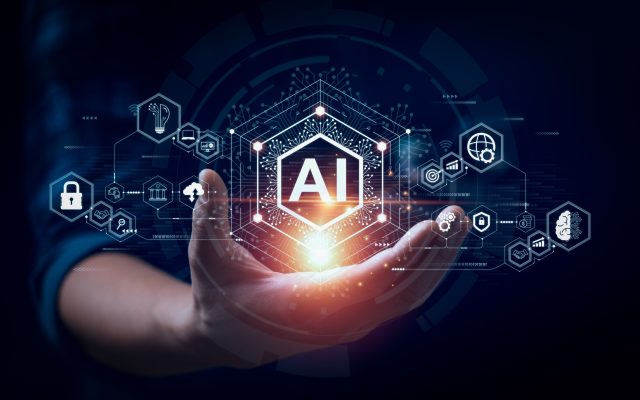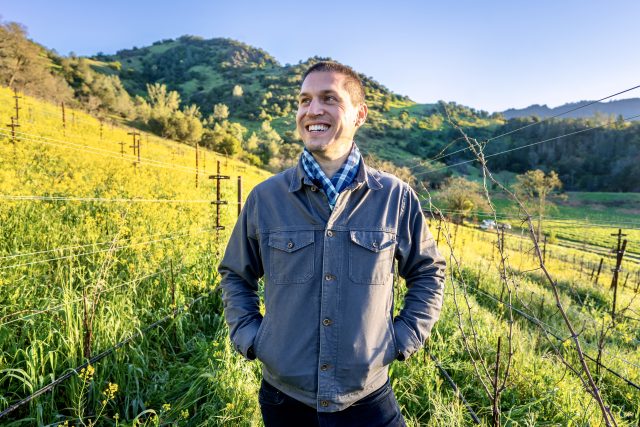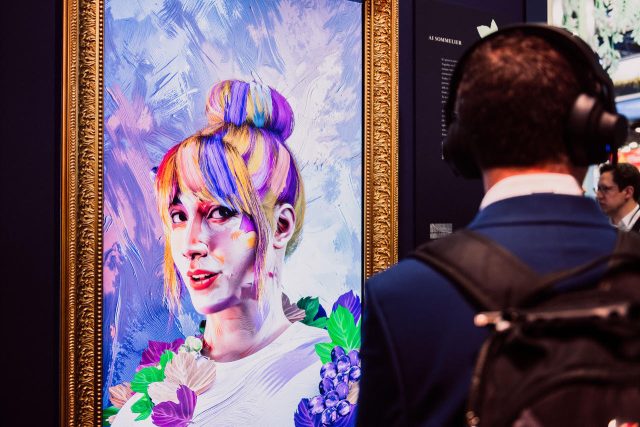This website uses cookies so that we can provide you with the best user experience possible. Cookie information is stored in your browser and performs functions such as recognising you when you return to our website and helping our team to understand which sections of the website you find most interesting and useful.
Five ways AI is impacting the wine trade
Artificial intelligence systems are here to stay, and every industry is grappling to remain a step ahead – wine is no exception, reports Lauren Eads.

Every industry is in the midst of figuring out the benefits and drawbacks of using artificial intelligence. In wine, its potential application is vast. From vineyard management to winemaking and marketing, AI’s impact can be felt at every level of the wine trade, influencing the way we grow, make, buy, sell and consume wine. While some will be sceptical about its use, many are welcoming its development and use it as a tool to help us work smarter, not harder.
“People in every industry should embrace AI to help shape it, and to evolve it in a way that meets human needs and values,” believes Pam Dillon, co-founder of Preferabli, an AI-driven wine recommendation app.
“I find this to be especially true for the wine industry. Our industry is older than many others, with a legacy of storytelling we want to preserve. Change from developments in AI is inevitable, with great potential for positive outcomes. The conversation in our industry should be about shaping outcomes that make our lives easier and better.”
AI can also be applied in the winery to make more efficient decisions, says Napa winemaker Matt Crafton, of Montelena. “AI is a tool,” he says.
“The tools I’m interested in are those that allow me to make better decisions, more quickly. The benefit to that framework is that, in theory, AI can be applied almost anywhere; the challenge is that AI is only as good as its training models. And most of those are still in their infancy.”
With this in mind, here are five areas of the wine trade that AI is most significantly impacting, and some the projects pushing its use further.
1.Viticulture and winemaking
Managing a vineyard traditionally involves the manual monitoring of soil, climate, irrigation and pest control. Now, AI can take over much of this work. Napa’s Chateau Montelena, owned by the Barrett family, is just one winery using AI in the vineyard. It monitors its vines in real time using AI to measure water usage to provide data on vine health and water needs, driving irrigation decisions that improve vine quality, conserve water, and save energy. It also uses AI and aerial images to monitor variations in ripening and stress across different vineyard blocks, allowing for targeted interventions.
“My hope is that the implementation of AI in the short term will augment many of the simple, repeatable tasks that compose winemaking,” says Matt Crafton, Chateau Montelena’s winemaker. “After that, who knows? For consumer-driven, data-derived wines that populate our grocery store shelves, AI could easily assume a greater role in final blend characteristics and composition. In my world, where creativity can’t be quantified, I’ll be happy with more precise, more actionable data.”
The issue of smoke taint is also being tackled by AI. Earlier this year, Tastry – an AI-powered robot that can ‘taste’ wines – explained how it’s technology was being used to tackle smoke taint in California. Tastry is able to identify changes in chemistry among grape varieties that might indicate smoke taint, so that winemakers can make decisions more quickly about the sale and marketing of a wine that might be affected and its potential evolution. Its CompuBlend technology also helps to salvage affected grapes by masking smoke taint, identifying optimal blends and fining agents to help to reduce the financial impact of smoke taint.

2.Wine education
There is huge potential for AI to be used in education in general – why not for wine education? Already it is easy to ask language-based AI model questions about anything and receive an accurate response, including wine. But as the technology develops, its answers will, in theory, become more reliable and detailed.
“I feel that it IS important that we embrace AI in wine education, a) because the horse has already bolted and I believe there is no turning back at this point, so we may as well adopt it, and b) because it can actually be beneficial,” says Master of Wine Anne McHale. “AI, particularly Large Language Models (LLMs), offers a unique opportunity to streamline and personalise wine education – particularly for theory exams. As I outlined in a recent piece for GuildSomm, LLMs can assist students by summarising complex information, creating study aids like flashcards, and improving written communication skills – all of which help reduce cognitive load and enhance learning efficiency. This allows more time for students to focus on higher-level skills, such as analysis and critical thinking, which are crucial for high-level qualifications like the WSET Diploma.”
Its use does come with a warning. An over reliance on AI could in fact diminish a student’s ability to think analytically, leading them to become “passive learners”, adds McHale. “It’s important to balance AI use with human judgement to ensure that students remain actively engaged in their education. Ethically, we must also be cautious with issues like copyright and data privacy. While AI can significantly enhance wine education, it must be used judiciously to avoid negative consequences.”
3.Fraud prevention
Last year a breakthrough in wine fraud prevention came from researchers in Bordeaux who unveiled a new AI tool that uses gas chromatography to separate and detect the specific chemical components of a wine. Researchers were able to analyse 80 wines harvested over 12 years from seven different estates in Bordeaux, with the AI able to recognise specific châteaux based on the clusters of compounds, tracing their origins. Professor Alexandre Pouget at the University of Geneva in Switzerland said it was able to map each “chemical signature specific to each château, independent of vintage”. In theory the technology could be used to detect fraudulent wines.
Similarly, in 2022, New Zealand company Oritain, unveiled its method of confirming a wine’s authenticity, by developing a “forensic fingerprint” based on the chemical composition of a specific terroir, capable of proving the exact location of a wine’s origins. Oritain’s method works by logging a unique chemical footprint of a terroir, which cannot be recreated, and can be matched to a wine’s chemical makeup. The reliability comes from the fact that soil chemistry changes very little over hundreds of years.
Both methods see verification measures applied to the liquid inside the bottle, rather than to a wine’s packaging.
4.‘Winemaking’, marketing and branding
While AI can allow winemaking to be carried out in a more data-driven manner, it can also weigh in on what wines should be sold where. AI is influencing wine marketing by predicting consumer trends. Machine learning models can analyse data from social media, consumer reviews, and sales to forecast future wine preferences and market trends. Wineries can use these insights to develop products that resonate with evolving consumer demands. Some are already experimenting with its use in the winery.
In 2023 Aubert & Mathieu, a wine producer in the Languedoc ‘made’ a wine under the instruction of ChatGPT, having asked what it thought would be the best wine to make in the south of France. Its advice was to make an organic Syrah-Grenache blend and to house it in a Burgundy-shaped bottle. It offered basic winemaking advice, which was adjusted by a winemaker, but the basic premise – the grapes, the label, the marketing – was given by ChatGPT. The result was a wine called, ‘The End’.
AI is also being used to produce wine labels. In August Bergerac-based producer, Maison Wessman, launched a limited edition wine where every label is unique, generated by AI. Using AI-enhanced graphics, Maison Wessman’s new Imprévu – the French word for “unexpected” – will see label designs that “clearly belong to the same family, but are all one-of-a-kind”.

5.Wine recommendations
While wine recommendation apps have long been in use, they have typically worked by using crowdsourced data, recommending the most popular wines based on previous purchases. AI has allowed this to go a step further. Preferabli is powered by a database of over a million wines and their specific aroma and flavour characteristics, captured by experts that include Masters of Wine and Master sommeliers. It allows you to enter any wine (beer or spirit) and be given an unbiased selection of others it thinks you personally will like, within its ever-growing database. Its code learns your preferences to build an individual 1:1 profile, which is unique to Preferabli and protected by 11 patents.
“Consider the thousands of wines in an inventory at any one time, say in a retail or hospitality setting,” explains Preferabli co-founder, Pam Dillon. “How can any one person hold them in their mind, at the same time they’re holding every customer’s individual taste preference in their mind? No one wants to even try to do that. Preferabli brought PhDs in physiology and applied mathematics together with the largest group of Masters of Wine and Master Sommeliers in the world to build our software – so it works like a human expert, at scale.”Some brands are using AI-driven virtual sommeliers to guide users through the buying process.

This summer, Moët Hennessy Wine Estates (MHWE) launched ‘Divine’ – an interactive AI sommelière, capable of talking buyers through wine recommendations. Divine runs on GPT4 technology, but was trained with a unique data set: with expertise in all of MHWE’s wineries, including Cloudy Bay in New Zealand, Ao Yun in China, Bodega Numanthia in Spain, Joseph Phelps in the US, Terrazas de los Andes in Argentina, and Chateau d’Esclans, Chateau Galoupet and Minuty in France. It currently takes the form of a ‘living painting’, which interacts via speech in real life. However, MHWE plans to develop the Divine technology into other applications in stores and online, influencing consumer’s buying decisions in store.
Related news
Vinitaly pits classic art against artificial intelligence
Atwater Brewing uses artificial intelligence to create beer recipe

